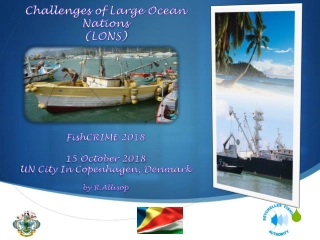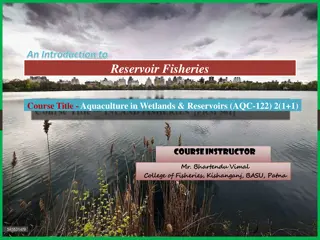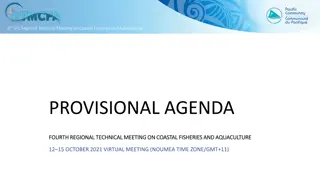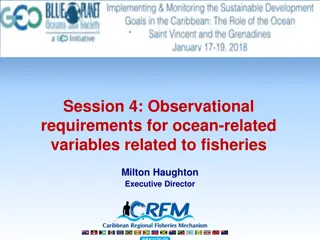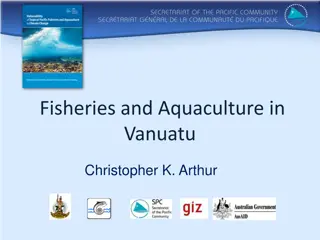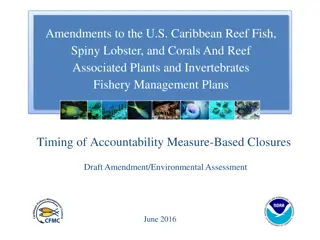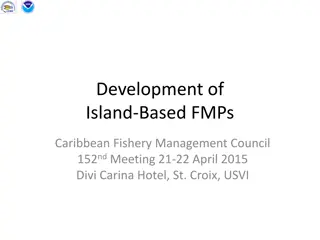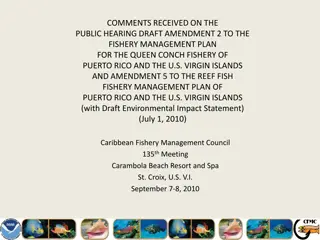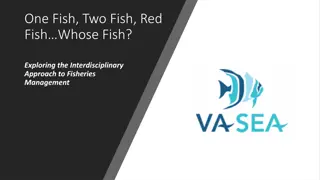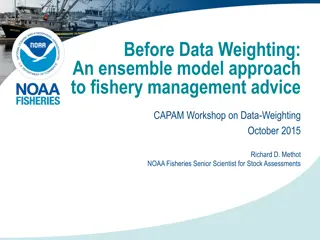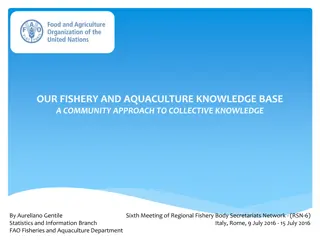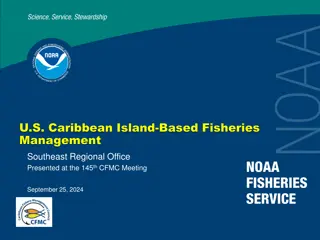Enhancing Fishery Management Strategies in Indian Reservoir Fisheries
The demand for fish in India is increasing rapidly, but natural fish production from reservoirs is limited. The average fish productivity in Indian reservoirs needs to be improved to meet population demands. Strategies for fishery enhancement focus on optimizing ecosystem utilization, modifying habitats, and increasing fish stocks. Various morpho-edaphic factors influence fishery enhancement activities in reservoirs, which cover a significant area in India and offer immense production potential.
Download Presentation

Please find below an Image/Link to download the presentation.
The content on the website is provided AS IS for your information and personal use only. It may not be sold, licensed, or shared on other websites without obtaining consent from the author.If you encounter any issues during the download, it is possible that the publisher has removed the file from their server.
You are allowed to download the files provided on this website for personal or commercial use, subject to the condition that they are used lawfully. All files are the property of their respective owners.
The content on the website is provided AS IS for your information and personal use only. It may not be sold, licensed, or shared on other websites without obtaining consent from the author.
E N D
Presentation Transcript
Management strategies for Reservoir Fisheries Mr. Bhartendu Vimal Guest Faculty-Asst. Professor CoF, Kishanganj, BASU, Patna
Gap between the increased demand for fish and the apparent limited growth for natural production, invoked the need for various forms of culture fisheries globally. This includes the enhancement of natural production in larger water bodies such as natural lakes and man-made reservoirs. The reservoir, a large man-made ecosystem and co-existence of fluviatile as well as lacustrine ecosystem The average fish productivity of reservoirs in India is nearly 30 Kg/ha, not sufficient enough to match the ever-doubling rate of population demands.
Table 1: Reservoir resources of India Type of reservoir Small Medium Large Number 19,134 180 56 Area (ha) 14,85,557 5,27,541 11,40,268 Table 2: Fish yield (Kg/ha) from Indian reservoirs Type of reservoir Small Medium Large Average fish yield (Kg/ha) 174 94 33
Any fishery enhancement activity in a reservoir should be based on the morpho- edaphic factors of the reservoir There are many reservoirs in India extending over an area of 3.0 million ha and distributed under divergent geo-climatic, morphometric and edaphic environments. The average productivity from these reservoirs in India is nearly 30 Kg/ha against the production potential of 250 Kg/ha. The recent strategies adopted in fisheries production are named as enhancement strategies. The enhancements are interventions in the physical or ecological functioning of aquatic resources which are dependent on a series of biotic and abiotic factors
The broad distinguishing features of small and large reservoirs
Physico-chemical features of lndian reservoirs (range of values)
Purpose of fishery enhancement Purpose of fishery enhancement The purpose of fishery enhancement strategies varies from fisheries development aspects It deals with optimizing the utilization of whole ecosystem and selective fishing down of the food webs, to manipulations of stock, species and environment which ensure stock increment and offering of favorable habitats through habitat modifications to closed enhancements including cages, pens and raceways.
Factors Affecting Fishery in a Reservoir Factors Affecting Fishery in a Reservoir Biotic and abiotic may be the two broad types of factors that determine the productivity from any reservoir The abiotic factors which are related to the geographical location and microclimate of the reservoir are independent variables beyond the control of fishery managers. Some of such factors include physical factors (morphometric, climatic, edaphic) and hydrologic factors. The biological factors such as food-web, community and evolutionary specifics also determine the fishery productivity from any natural environment
The production potential of culture-based fisheries is strongly linked to ecosystem productivity, which is mainly based on physical and biological factors and also on the basis of natural production. Manipulations in these factors may change the natural carrying capacity which would eventually influence production from any system. The enhanced production of fisheries may be obtained using these factors in the following ways: a) Enhancement using natural production basis b) Enhancements through manipulation of the physical base of production c) Enhancements based on biological basis of production d) Enhancements through Culture-Based Systems: From Open to Closed Aquaculture
Enhancement using natural production basis Enhancement using natural production basis The enhancement methods using natural production basis in reservoirs vary with the size of the reservoirs. Mesh size and gear restrictions are among the most easily applied management regulations. Mesh size restriction involves regulation of the exploitation rate or the exploitation pattern through effort control and is practiced in Indian reservoirs during stocking programme. These regulations result in utilizing maximum productivity of ecosystems by exploiting the small pelagics, or by fishing down the ecosystem or by reducing the predator masses
Enhancements through manipulation of the physical Enhancements through manipulation of the physical base of production base of production This strategy involves the manipulation of physical factors affecting fish production. Latitude determines the physical factors like climatic conditions, which again control variables such as temperature, light, annual insolation, seasonal variation, wind and precipitation. All these play a major role in the nutrient cycles and hence the regeneration of biomass. These enhancements may be classified into edaphic, nutrient, hydrological and habitat enhancements.
Edaphic enhancements Edaphic enhancements The edaphic conditions determine the chemical composition of the soil in the surrounding watershed, and thus the supply of nutrients and trace elements for organic synthesis. Thus, the enhancements based on manipulations in edaphic factors depend on the nutrient status of the water body and soil along with the physical variables such as specific conductivity, total alkalinity etc. The morphology of a reservoir, particularly area, volume, depth, and shoreline development or gradient, is also of major importance to the productivity. The mean depth is a single morphometric parameter used to estimate the production potential of a reservoir
Enhancements based on biological basis of production Enhancements based on biological basis of production Biological enhancements can be done through manipulation of the fish community and culture based systems: from open to closed aquaculture. Fish community can be manipulated using species introductions and stock enhancements. Species introduction: Species introductions into a reservoir system area controversial issue on account of the competition offered by the introduced species at various levels to the endemic fishes of the system. Oreochromis Hypophthalmichthys molitrix, Clarias gariepinus and Cyprinus carpio have gained entry to Indian reservoir system. The impacts of these entries were already discussed. Accidental introduction of Silver carp is a great example in the Indian context mossambicus, Ctenopharyngodon idella, Stock enhancements: This enhancement strategy has been concluded into 4 types mainly single species, multiple species, predator enhancement and predator control. Stock enhancement may be done either by altering the species itself or by altering the relative stock density. Usually, in India, these include mixtures of bottom feeders, higher vegetation feeders and pelagic zooplankton and phytoplankton feeders, which is otherwise a relative proportion of Indian Major Carps. This multispecies enhancement strategy is usually applied across India.
Enhancements through Culture Enhancements through Culture- -Based Systems: From Open to Closed Based Systems: From Open to Closed Though interventions from coves to finger ponds have been applied in reservoirs. Another step towards more closed systems comparable with more intensive forms of land-based aquaculture is cage-cultures. Cultures have the advantage above land-based systems that they do not make claims on scarce land resources. Cage cultures have developed independently, but are often closely associated with other forms of enhancement. Among the synergetic effects are stocking through escapement of cultured species from cages to the wild and through the eutrophication of the lake environment through the leaching of nutrients and excess food into the natural environment
Challenges in Enhancement Strategies Challenges in Enhancement Strategies i. Available natural production basis: There is a need to investigate spatial and temporal dynamics of fishing effort in small scale fisheries and their capacity to react and adapt to fluctuating environments ii. Physical basis of production: For lakes and reservoirs, more studies are needed to understand impact of hydrological and edaphic fluctuations in relation to productivity iii. Biological basis for production: The pelagic zone in many reservoirs has no indigenous lacustrine fish fauna and therefore remains uninhabited and underutilized from a fishery perspective Hence, meta-analysis of different experimental data and information on enhancement practices is needed


